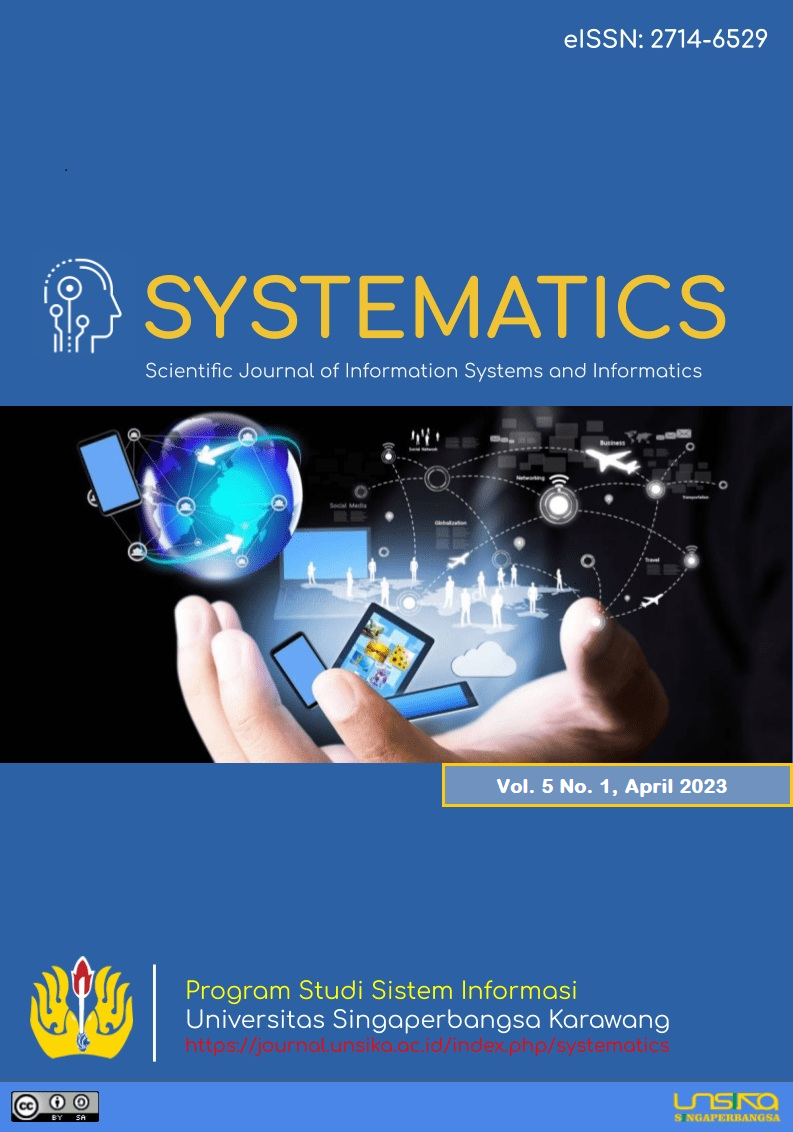Decision Support System Using Simple Additive Weighting (SAW) Method For Teacher Performance Assessment At SMP Ki Hajar Dewantoro
Sistem Pendukung Keputusan Menggunakan Metode Simple Additive Weighting (SAW) Untuk Penilaian Kinerja Guru Di SMP Ki Hajar Dewantoro
DOI:
https://doi.org/10.35706/sys.v5i1.8660Abstract
The teacher is a qualified educator who is responsible for teaching, and has a function and role in educating the nation's daily life. So that the roles and responsibilities in the teacher's functional position to be done according to the applicable regulations, a teacher's work assessment is needed which can guarantee a quality learning process at SMP Ki Hajar Dewantoro. In the process of selecting the best teacher for SMP Ki Hajar Dewantoro, there was already a weighting of the assessment criteria. However, a number of challenges arise, including the procedure of assessing teacher performance still using conventional methods with paper and ordinary calculations, so that the results of the assessment can occur errors or are inaccurate, and take a little time. Teacher ratings are also inaccurate and subjective, making it difficult to determine the best teacher. In addition, the decree for the best teacher is not well preserved. Therefore, a Decision Support System (DSS) is needed to recommend the best teacher using thethe Technique known as SAW (Simple Additive Weighting). The SAW approach was chosen due to it uses a method of ranking to choose the best option from a number of others and then determines the preference weight value for each option, specifically, the teacher with the highest rank according to the specified standards. due to the fact that it is based on the weight value of the existing criteria, this method will make the assessment faster, it can provide the best alternative teacher ranking. With the results of these rankings, it can simplify and assist the school in accelerating the assessment of teacher performance, so that more accurate results will be obtained as a decision tool.
Downloads
References
A. F. Mustofa dan M. I. Majaruni, “Sistem Pendukung Keputusan Penilaian Kinerja Guru Menggunakan Metode Simple Additive Weighting,” Cahaya tech, vol. 7, no. 1, hal. 1–11, 2018, doi: 10.47047/ct.v7i1.1.
R. Taufiq dan C. A. Saputra, “Perancangan Sistem Pendukung Keputusan Penilaian Kinerja Guru Menggunakan Metode SAW Pada SMAN 15 Tangerang,” J. Sist. Inf. dan Komput., vol. 7, no. 1, hal. 75–80, 2018, doi: 10.32736/sisfokom.v7i1.297.
C. Rizal, “Sistem Pendukung Keputusan Penentuan Guru Dan Pegawai Terbaik Menggunakan Metode SAW (Simple Additive Weighting),” J. Tek. dan Inform., vol. 6, no. 2, hal. 1–17, 2019.
A. V. Oktavia dan G. Gata, “Penilaian kinerja guru terbaik pada SMK Putra Satria dengan menggunakan metode SAW,” J. IDEALIS, vol. 3, no. 1, hal. 314–321, 2020.
N. D. Apriani, N. Krisnawati, dan Y. Fitrisari, “Implementasi Sistem Pendukung Keputusan Dengan Metode SAW Dalam Pemilihan Guru Terbaik,” J. Autom. Comput. Inf. Syst., vol. 1, no. 1, hal. 37–45, 2020, doi: 10.47134/jacis.v1i1.5.
E. Turban, T.-P. Liang, dan J. E. Aronson, Decision Support Systems and Intelligent Systems:(International Edition). Pearson Prentice-Hall Upper Saddle River, NJ, USA:, 2005.
A. Ratih dan K. Khotimah, “ANALISIS FISHBONE Impartiality Management at LSP BATAN with Fishbone Analysis Approach,” 2021.
Muhamad Syarif dan Wahyu Nugraha, “Pemodelan Diagram Uml Sistem Pembayaran Tunai Pada Transaksi E-Commerce,” J. Tek. Inform. Kaputama, vol. 4, no. 1, hal. 64–70, 2020.
S. Prof. Dr. Ir. Riri Fitri Sari, M.M., M.Sc., DTM dan A. Utami, REKAYASA PERANGKAT LUNAK BERORIENTASI OBJEK MENGGUNAKAN PHP. Penerbit Andi, 2021.
J. W. Satzinger, R. B. Jackson, dan S. D. Burd, Systems Analysis and Design in a Changing World. Cengage Learning, 2015.
J. A. O’brien dan G. M. Marakas, Management Information Systems, vol. 9. New York: McGraw-Hill/Irwin, 2011.
B. F. T. Sopian dan Ermatita, “Penerapan Metode Simple Additive Weighting (SAW) Pada Sistem Pendukung Keputusan Dalam Pemilihan Paket Layanan Internet,” in Seminar Nasional Mahasiswa Ilmu Komputer dan Aplikasinya (SENAMIKA), 2021, vol. 2, no. 1, hal. 502–512, doi: 10.55340/jiu.v10i1.526.
Downloads
Published
How to Cite
Issue
Section
License
Copyright (c) 2023 SYSTEMATICS

This work is licensed under a Creative Commons Attribution-ShareAlike 4.0 International License.
Authors who publish with this journal agree to the following terms:
- Authors retain copyright and grant the journal right of first publication with the work simultaneously licensed under a Creative Commons Attribution-ShareAlike 4.0 International License. that allows others to share the work with an acknowledgement of the work's authorship and initial publication in this journal.
- Authors are able to enter into separate, additional contractual arrangements for the non-exclusive distribution of the journal's published version of the work (e.g., post it to an institutional repository or publish it in a book), with an acknowledgement of its initial publication in this journal.
- Authors are permitted and encouraged to post their work online (e.g., in institutional repositories or on their website) prior to and during the submission process, as it can lead to productive exchanges, as well as earlier and greater citation of published work (See The Effect of Open Access).







